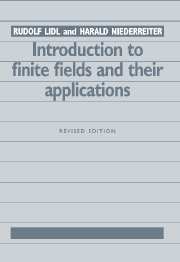Book contents
- Frontmatter
- Contents
- Preface
- Preface to the revised edition
- Chapter 1 Algebraic Foundations
- Chapter 2 Structure of Finite Fields
- Chapter 3 Polynomials over Finite Fields
- Chapter 4 Factorization of Polynomials
- Chapter 5 Exponential Sums
- Chapter 6 Linear Recurring Sequences
- Chapter 7 Theoretical Applications of Finite Fields
- Chapter 8 Algebraic Coding Theory
- Chapter 9 Cryptology
- Chapter 10 Tables
- Bibliography
- List of Symbols
- Index
Chapter 6 - Linear Recurring Sequences
Published online by Cambridge University Press: 05 June 2012
- Frontmatter
- Contents
- Preface
- Preface to the revised edition
- Chapter 1 Algebraic Foundations
- Chapter 2 Structure of Finite Fields
- Chapter 3 Polynomials over Finite Fields
- Chapter 4 Factorization of Polynomials
- Chapter 5 Exponential Sums
- Chapter 6 Linear Recurring Sequences
- Chapter 7 Theoretical Applications of Finite Fields
- Chapter 8 Algebraic Coding Theory
- Chapter 9 Cryptology
- Chapter 10 Tables
- Bibliography
- List of Symbols
- Index
Summary
Sequences in finite fields whose terms depend in a simple manner on their predecessors are of importance for a variety of applications. Such sequences are easy to generate by recursive procedures, which is certainly an advantageous feature from the computational viewpoint, and they also tend to have useful structural properties. Of particular interest is the case where the terms depend linearly on a fixed number of predecessors, resulting in a so-called linear recurring sequence. These sequences are employed, for instance, in coding theory (see Chapter 8, Section 2), in cryptography (see Chapter 9, Section 2), and in several branches of electrical engineering. In these applications, the underlying field is often taken to be F2, but the theory can be developed quite generally for any finite field.
In Section 1 we show how to implement the generation of linear recurring sequences on special switching circuits called feedback shift registers. We discuss also some basic periodicity properties of such sequences. Section 2 introduces the concept of an impulse response sequence, which is of both practical and theoretical interest. Further relations to periodicity properties are found in this way, and also through the use of the so-called characteristic polynomial of a linear recurring sequence. Another application of the characteristic polynomial yields explicit formulas for the terms of a linear recurring sequence. Maximal period sequences are also defined in this section. These sequences will appear in various applications in later chapters.
- Type
- Chapter
- Information
- Introduction to Finite Fields and their Applications , pp. 189 - 255Publisher: Cambridge University PressPrint publication year: 1994
- 2
- Cited by



